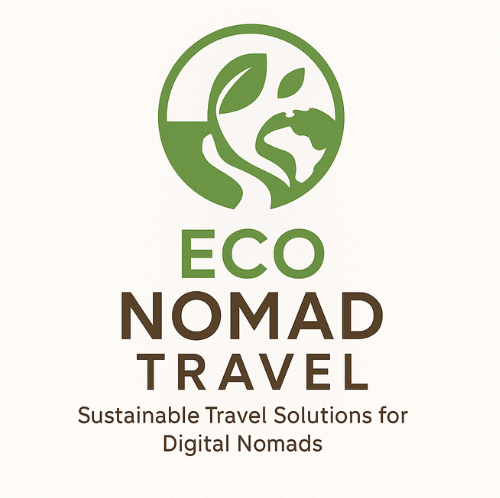
10 Best Sustainable Destinations for Digital Nomads in 2025
Quick Navigate
- Introduction: The Rise of Digital Nomadism
- Criteria for Selecting Sustainable Destinations
- Destination 1: Bali, Indonesia
- Destination 2: Lisbon, Portugal
- Destination 3: Austin, Texas, USA
- Destination 4: Chiang Mai, Thailand
- Destination 5: Medellín, Colombia
- Destination 6: Tbilisi, Georgia
- Destination 7: Cape Town, South Africa
- Destination 8: Edinburgh, Scotland
- Destination 9: Reykjavik, Iceland
- Destination 10: Ljubljana, Slovenia
- Extra Planning: Visas, Budget, Connectivity, and Low-Carbon Moves
- Smart Gear & Packing for Sustainable Nomads
- Housing, Community & Respectful Presence
- Helpful Internal Guides
- Conclusion: Finding Your Ideal Sustainable Destination
Disclosure: affiliate links may earn us a commission at no extra cost to you.
Introduction: The Rise of Digital Nomadism
Freedom to Work Anywhere
In recent years, digital nomadism has gained momentum as remote work opportunities expand across industries. This lifestyle allows individuals to merge professional responsibilities with travel, creating flexible work environments anywhere. Consequently, destinations catering to digital nomads are transforming both tourism and local economies.
Cultural Exploration and Creativity
The appeal lies in freedom. Digital nomads explore cultures, landscapes, and communities while maintaining steady income through remote employment. Additionally, benefits include flexible schedules and opportunities to immerse in diverse environments that inspire creativity and personal growth.
Sustainability Becomes Essential
As more professionals adopt this lifestyle, they redefine workplace norms. Therefore, adaptability becomes essential, with sustainability emerging as a central priority for many nomads worldwide.
The need for low-carbon travel and eco-friendly cities reflects growing awareness of environmental impact. Accordingly, travelers seek destinations with green coworking spaces and sustainable amenities that align with responsible consumption.
Understanding the intersection of remote work and sustainability is critical. Thus, by 2025, digital nomads increasingly pursue climate-friendly places to live and work without compromising the planet.
Criteria for Selecting Sustainable Destinations
Environmental Impact
Selecting sustainable destinations is vital for reducing environmental footprints while enjoying flexible remote work. Therefore, specific criteria guide nomads toward eco-conscious choices in 2025.
First, environmental impact matters most. Destinations must manage waste effectively, reduce pollution, and conserve ecosystems. Opting for low-carbon travel supports regions protecting natural resources.
Renewable Energy Commitment
Second, renewable energy commitment is essential. Solar, wind, or hydro usage demonstrates reduced fossil fuel reliance and a clear dedication to sustainability.
Community Engagement
Third, community engagement is key. Sustainable destinations encourage supporting local businesses and participating in events, fostering positive relationships between nomads and residents.
Eco-Friendly Accommodations
Finally, eco-friendly accommodations are necessary. Sustainable buildings, energy-efficient appliances, and access to green spaces promote healthier lifestyles for remote workers worldwide.
By applying these criteria, digital nomads ensure their choices reflect environmental responsibility while enhancing personal well-being.
Destination 1: Bali, Indonesia
Coworking and Connectivity
Bali has become a premier digital nomad hub in 2025. Moreover, it strongly appeals to sustainability-minded professionals worldwide.
The island is famous for scenic landscapes and green coworking spaces. These hubs provide fast internet while encouraging collaboration among professionals.
Visa and Lifestyle
Indonesia now offers multiple nomad visas, making Bali more attractive. Consequently, remote workers balance career and leisure with greater ease.
Sustainability Practices
Sustainability is central in Bali. Coworking spaces often use solar energy and rainwater systems to minimize ecological impact.
Bali also provides low-carbon travel opportunities, from lush rice terraces to peaceful coastal villages. Thus, it offers eco-conscious exploration.
Local markets and organic farms support healthy lifestyles and sustainable agriculture. Furthermore, they strengthen community resilience against global pressures.
Affordability and Culture
Affordability adds appeal. Bali allows nomads to live comfortably at lower costs compared to major global cities.
Ultimately, Bali blends culture, sustainability, and affordability, making it one of the best eco-friendly cities for remote work in 2025.
Destination 2: Lisbon, Portugal
Green Infrastructure
Lisbon is increasingly recognized as a leading sustainable city for digital nomads. Moreover, its integration of green initiatives sets it apart.
Public transport is extensive, featuring trams, buses, and trains. As a result, car reliance decreases, lowering emissions significantly.
Coworking Community
Green coworking spaces thrive in Lisbon. Many adopt renewable energy, waste reduction, and sustainable building practices to support eco-friendly work.
These hubs also encourage collaboration and idea-sharing. Therefore, nomads find community while working in productive, environmentally conscious settings.
Urban and Natural Balance
Lisbon’s numerous parks and gardens promote well-being. Furthermore, they create balance by combining urban living with natural serenity.
With stunning architecture and rich history, Lisbon offers cultural depth. At the same time, it promotes climate-friendly living and working.
Thus, Lisbon remains one of the most attractive destinations for sustainable nomads in 2025.
Destination 3: Austin, Texas, USA
Technology and Sustainability
Austin has emerged as a thriving hub for digital nomads. Its strong tech industry combines seamlessly with sustainability initiatives.
Green Workspaces and Food
Green coworking spaces are widespread. Many integrate solar panels, recycling programs, and energy efficiency into their design and operation.
Local food movements also thrive. Numerous eateries source from nearby farms, reducing carbon emissions while supporting community agriculture.
Lifestyle and Culture
Outdoor living is central to Austin. With bike lanes, walking paths, and mild weather, nomads easily enjoy an active lifestyle.
Cultural richness enhances the city’s appeal. Festivals, art, and music create vibrant experiences for locals and newcomers alike.
Therefore, Austin exemplifies innovation, sustainability, and inclusivity, making it one of the best eco-friendly cities for remote work in 2025.
Destination 4: Chiang Mai, Thailand
Community and Agriculture
Chiang Mai is a favorite for nomads seeking sustainability. Its affordability and eco-conscious community make it highly appealing.
The city promotes organic farming and offers volunteering opportunities. These initiatives reduce footprints while teaching sustainable agricultural practices.
Green Spaces and Education
Green coworking spaces and eco-friendly cafes are plentiful. Many use renewable energy and reduce waste, supporting sustainable work habits.
Workshops and events raise environmental awareness. Consequently, both locals and travelers engage actively in sustainability education.
In summary, Chiang Mai blends affordability, culture, and eco-conscious practices, making it a standout destination for sustainable nomads.
Destination 5: Medellín, Colombia
Urban Transformation
Medellín has become a global model for urban sustainability. Its transformation appeals strongly to digital nomads seeking eco-friendly lifestyles.
The Medellín Metrocable reduces fossil fuel reliance. At the same time, it improves access between hillside communities and urban centers.
Culture and Climate
Green coworking spaces integrate waste reduction, energy efficiency, and balanced work-life practices. Therefore, they align perfectly with eco-conscious nomad values.
Year-round spring weather makes Medellín comfortable for work and exploration. Additionally, cultural festivals and art scenes enrich daily life.
Ultimately, Medellín combines innovation, sustainability, and vibrant culture, positioning itself as a leading destination for eco-friendly digital nomads in 2025.
Destination 6: Tbilisi, Georgia
Cultural Blend
Tbilisi is rapidly gaining recognition as a sustainable hub. Its blend of culture and eco-conscious practices attracts global nomads.
Workspaces and Affordability
Green coworking spaces prioritize environmental stewardship. Equipped with sustainable technologies, they minimize ecological impact while fostering collaboration.
Tbilisi also remains affordable. Therefore, nomads enjoy a rich cultural experience without excessive living expenses.
Local hospitality strengthens community bonds. As a result, nomads feel welcomed and engaged within Tbilisi’s growing global community.
Thus, Tbilisi stands out as a sustainable and culturally rich destination for digital nomads in 2025.
Destination 7: Cape Town, South Africa
Natural Beauty and Conservation
Cape Town merges natural beauty with sustainability. Its dedication to conservation draws eco-conscious digital nomads from around the world.
Green Coworking and Culture
The city promotes green coworking spaces using solar power and water-saving measures. Additionally, waste reduction strategies are widely encouraged.
Outdoor experiences abound, from hiking Table Mountain to exploring beaches. These opportunities inspire healthier and more sustainable lifestyles.
Cultural diversity enriches Cape Town. Festivals, art, and community events foster meaningful engagement among nomads and locals.
Therefore, Cape Town is not just scenic—it is a sustainable hub for digital nomads seeking eco-friendly living in 2025.
Destination 8: Edinburgh, Scotland
Green Policies and Infrastructure
Edinburgh, the capital of Scotland, stands out as a remarkable destination for digital nomads who prioritize sustainability in their lifestyle. With its rich cultural heritage, stunning architecture, and vibrant arts scene, the city presents an inviting atmosphere for remote work while also emphasizing eco-friendly initiatives. The city has adopted various green policies, aiming to reduce carbon emissions and promote sustainable living, making it one of the best eco-friendly cities for remote work.
Eco-Conscious Coworking
Noteworthy are the extensive green coworking spaces emerging across Edinburgh. These spaces are not only designed to enhance productivity but also incorporate sustainable practices. Many coworking venues utilize renewable energy sources, reduce waste, and promote eco-conscious habits among their members. This alignment with sustainability makes the city an ideal place for those adopting a digital nomad lifestyle in 2025, where the focus is on multiple facets of sustainable living.
Walkability and Parks
Moreover, Edinburgh is renowned for its pedestrian-friendly infrastructure. The layout of the city facilitates easy navigation by foot or bicycle, encouraging low-carbon travel destinations within its borders. This commitment to sustainable transport alternatives ensures that residents and visitors alike can explore the city without relying heavily on motor vehicles, thus reducing their carbon footprint.
The Scottish capital also boasts a variety of parks and green spaces, contributing to its appeal as a sustainable remote work location. From the iconic Arthur’s Seat to the beautiful Princes Street Gardens, these areas serve as rejuvenating escapes for individuals balancing work and leisure. As Edinburgh continues to invest in its green initiatives and adaptable infrastructure, it solidifies its position as a leading destination for digital nomads seeking climate-friendly places to live and work.
Destination 9: Reykjavik, Iceland
Renewable Energy Leadership
Reykjavik, the capital of Iceland, is emerging as a premier destination for digital nomads who prioritize sustainability and a deep connection to nature. Renowned for its breathtaking landscapes characterized by cascading waterfalls, volcanic terrains, and stunning glaciers, Reykjavik is not only about dramatic scenery; it also stands out for its commitment to renewable energy. The city’s energy grid is primarily powered by geothermal and hydroelectric sources, making it one of the most eco-friendly cities for remote work globally.
Culture of Environmental Stewardship
The local culture of environmental stewardship is palpable throughout the city. Residents and local governments actively promote initiatives that encourage sustainable living, aligning perfectly with the ethos of the digital nomad lifestyle in 2025. From recycling programs to green building practices, Reykjavik exemplifies a model for climate-friendly places to live and work.
Work and Travel Balance
For remote workers, Reykjavik offers numerous green coworking spaces, which foster a productive and eco-conscious work environment. These spaces not only provide reliable high-speed internet but also encourage collaboration among like-minded professionals seeking sustainable remote work locations. Many of these coworking spots are integrated into the natural landscape, allowing individuals to enjoy the beauty of nature while being productive.
Moreover, Reykjavik serves as a hub for low-carbon travel destinations, with most attractions easily accessible by foot or bike. Whether it’s exploring the unique geothermal pools or embarking on adventures to witness the Northern Lights, every experience is amplified by a commitment to preservation and sustainability.
As the world shifts towards more sustainable practices, Reykjavik stands out as an ideal location for digital nomads looking to balance work and environmental responsibility while fully immersing themselves in Iceland’s enchanting natural beauty.
Destination 10: Ljubljana, Slovenia
European Green Capital
Ljubljana, Slovenia’s capital, is celebrated as one of Europe’s greenest cities. Its proactive approach to sustainability sets it apart.
Walkable and Bike-Friendly City
Named European Green Capital, Ljubljana prioritizes reduced car use, expanded pedestrian cores, and a bike-forward network supported by efficient buses and rail links.
Much of the center is pedestrian-only, encouraging safe exploration and lowering emissions. Abundant parks and riverside paths add restorative green space to everyday life.
Community and Transparency
Community projects and city data transparency strengthen long-term sustainability and preserve Ljubljana’s natural charm—an excellent fit for eco-minded nomads seeking a human-scaled base.
Extra Planning: Visas, Budget, Connectivity, and Low-Carbon Moves
Remote Work Visas & Longer Stays
Prioritize destinations offering digital-nomad or remote-work visas to support slow travel. Longer, compliant stays reduce flight frequency while enabling deeper community ties and more sustainable routines. Always verify requirements with official government sites before booking.
Quick prep checklist: proof of income (last 3–6 months), international health insurance, clean background check, address of accommodation (initial booking is fine), and apostilled documents where required. Keep high-res scans encrypted in cloud storage and share via expiring links.
Timing tips: many visas take 2–8 weeks. Apply from your home country if possible; some programs require it. Build a 30-day buffer before your current permission expires to avoid forced flights.
Tax & compliance basics (not legal advice): a visa ≠ tax residency. Track days in each country, consult a cross-border tax pro, and use an app to log presence and expenses. Keep separate accounts for business vs. personal to simplify filings.
Budgeting for a Low-Impact Lifestyle
Allocate intentionally: transit passes over ride-hails, local markets over imported groceries, and quality gear that lasts over fast fashion. Sustainable choices often reduce total cost of living while improving daily experience.
- Rule of thirds: ⅓ housing, ⅓ food & transit, ⅓ savings/gear/experiences. Rebalance monthly as prices change.
- Housing: monthly rentals are 20–40% cheaper than nightly rates; ask for utility caps and written recycling/energy policies.
- Transit: city passes often break even in 5–7 rides; pair with a folding grocery tote and skip delivery fees/packaging.
- Dine local: street markets + refillable containers cut cost and waste; learn “no disposable cutlery” in the local language.
Emergency fund: target 3 months of expenses + one last-minute flight. Keep it in a separate account so it doesn’t “evaporate.”
Connectivity that Cuts Waste
Choose energy-efficient laptops and enable offline workflows to reduce constant syncing. Activate an eSIM to skip plastic cards and shop visits—try Airalo for instant coverage. Use dark modes and scheduled syncs to cut energy use.
- Speed sanity: test coworking and rental Wi-Fi with up/down/ping; 20/5 Mbps with <80 ms ping comfortably supports most calls.
- Redundancy: travel router + phone hotspot + eSIM. Download offline maps/docs before border crossings.
- Power: 65–100W GaN charger + universal adapter; charge during off-peak hours if your building uses time-of-use energy pricing.
Door-to-Door Transport Strategy
For sub-800 km corridors, rail often matches or beats short-haul flight time once you count transfers and security. Compare door-to-door time and CO₂ using our guide: Train vs Plane Emissions 2025. When you must fly, book nonstop and pack light.
- Pack math: every 10 kg you leave at home saves fuel—and your back.
- Cluster moves: plan regions in 6–12 week blocks; string cities by rail/bus to avoid “ping-pong” flights.
- Night trains/buses: convert transit into lodging to cut cost and emissions in one move.
Smart Gear & Packing for Sustainable Nomads
Zero-Waste Core Kit
Carry a purifier bottle, solids/refills for toiletries, a collapsible container, and a compact repair kit. This reduces single-use waste while making markets and street food simpler.
- Hydration: purifier bottle (virus-rated) + tiny dish soap sheet; refill at public fountains/cafes that allow it.
- Toiletries: bar shampoo/conditioner + refillable deodorant; store in a tin to dodge leaks and plastic.
- Repair: mini sewing kit, tenacious tape, spare screws for glasses/laptop, zip ties, and 2 binder clips (they fix everything).
Durable, Versatile Wardrobe
Choose breathable, fast-dry fabrics and a neutral capsule to downsize luggage and laundry frequency. See our full checklist: Zero-Waste Packing List 2025.
- Capsule: 2 bottoms, 4–5 tops, 1 mid-layer, 1 shell, 1 versatile shoe + sandals. Aim to wash weekly, not daily.
- Fabric picks: merino or Tencel for odor control; recycled nylon for durability; avoid cotton socks in humid regions.
- Laundry: travel-sized concentrate + sink plug; choose accommodations with line-dry space to skip energy-heavy dryers.
Navigation, Dining & Stays
Use HappyCow for plant-forward spots and map water refill points via Refill. When booking, filter for transit-served stays with published energy/water policies—compare responsibly with HotelLook.
- Quiet work zones: pack wired earbuds (lower battery drain) and a small USB mic; pick rooms with soft furnishings to reduce echo.
- Power strip: 3-port travel strip prevents wall-wart madness and reduces outlet hunting in cafes.
- Workspace ergonomics: ultralight laptop stand + external keyboard/mouse = fewer physio bills.
Housing, Community & Respectful Presence
Choose the Right Base
Pick walkable, transit-rich neighborhoods near coworking and markets to reduce transport needs. Avoid displacing locals by favoring licensed stays and longer leases where appropriate.
- Red flags: “party streets,” nightly rentals in residential buildings with local pushback, or listings without tax/license numbers.
- Good signs: landlords who publish energy/water policies, recycling instructions, and neighborhood guides for small businesses.
- Noise & respect: observe quiet hours, use door closers softly, and keep shared spaces tidy—your neighbors are your reputation.
Spend Where It Sticks
Buy from owner-operated businesses and community projects, take small-group tours, and tip fairly. Learn a few phrases to unlock markets and repairs and build positive relationships.
- Local loop: weekly markets, repair cafés, cooperatives, and community kitchens keep money circulating nearby.
- Skills swap: offer design, translation, or web help to local orgs a few hours a month—lightweight, high impact.
- Learn & share: take a short class (cooking, craft, language) and credit teachers when posting to social.
Nature, Culture & Capacity
Respect visitor caps, reef-safe rules, and wildlife distances. Travel off-peak and choose adjacent sites to help spread load—your experience is often better too.
- Trails & parks: stick to paths; wash boots to prevent invasive seeds; pack out all trash including organics.
- Wildlife: 25–100 m distance depending on species; no drones near nesting/breeding zones.
- Culture: ask before photographing people or religious spaces; dress in line with local norms away from beaches.
Leave-it-better micro-habit: carry a quart-sized bag to collect small litter on walks. Two minutes a day adds up, and locals notice.
Conclusion: Finding Your Ideal Sustainable Destination
Why Sustainable Choices Matter
As the digital nomad lifestyle continues to evolve, the importance of choosing sustainable travel destinations for remote work cannot be overstated. In 2025, embracing eco-friendly practices while traveling is not merely a trend but a necessity for fostering a positive impact on our planet and local communities. By opting for destinations that promote low-carbon travel and sustainable living, digital nomads can contribute to preserving the environment and supporting local economies.
Key Factors for Eco-Friendly Remote Work
When selecting the best eco-friendly cities for remote work, it is essential to consider factors such as access to green coworking spaces, availability of low-impact transportation options, and the commitment of local authorities to sustainability initiatives. Integrating the principles of sustainability into daily travel practices allows digital nomads to experience new cultures while promoting environmentally responsible choices.
Learning from Experience
Reflecting on past experiences and future journeys can inspire digital nomads to explore climate-friendly places to live and work. By prioritizing destinations that actively work towards sustainability, nomads not only enhance their travel experiences but also encourage communities to adopt more eco-friendly practices. This symbiotic relationship benefits both travelers and locals, as it fosters economic growth while minimizing ecological footprints.
Taking Action for the Future
Ultimately, adopting a sustainable mindset and actively seeking out sustainable remote work locations will shape a more responsible travel culture. It encourages individuals to engage meaningfully with the places they visit, ensuring that their presence does not come at the expense of the environment or local communities. As you chart your path in the digital nomad lifestyle 2025, let sustainability guide your choices and pave the way for transformative experiences that support a healthier planet for future generations.
For deeper insights on sustainable tourism principles, check out this excellent guide from the United Nations Environment Programme.
Continue your journey with our in-depth guide: Sustainable Travel Guide 2025.
FAQs: Sustainable Destinations for Digital Nomads (2025)
What makes a destination sustainable for digital nomads?
Strong public transit, renewable energy, green coworking, fair wages, recycling, and policies that protect nature and culture.
Which regions lead in eco-friendly nomad hubs for 2025?
Europe (Slovenia, Portugal, Spain), Latin America (Costa Rica, Colombia), and Asia (Bali, Thailand) show strong sustainability momentum.
How can I verify that a stay or coworking space is truly green?
Look for certifications (Green Key, EarthCheck, LEED, B Corp), public impact reports, local hiring, and measurable energy and water savings.
Do sustainable destinations offer reliable internet for remote work?
Yes. Most hubs have fiber or 5G in cities and coworking spaces. Carry an eSIM and hotspot as backup.
What visas support longer, lower-impact stays in 2025?
Digital nomad or remote work visas from countries like Portugal, Spain, Estonia, and Barbados encourage slow travel and deeper roots.
How can I cut emissions when traveling between destinations?
Choose trains and buses, fly non-stop only when necessary, pack light, combine trips, and stay longer to reduce flight frequency.
What daily habits lower my footprint while living abroad?
Walk or bike short trips, refill water, eat seasonal plant-forward meals, refuse disposables, reuse linens, and shop from local vendors.
What belongs in a sustainable packing list for nomads?
Filtered reusable bottle, utensil set, collapsible container, tote bag, solid toiletries, solar charger, repair kit, and versatile clothing.
How do I avoid greenwashing when choosing tours or activities?
Prefer community-led operators with conservation goals, transparent metrics, no wildlife contact, and independent third-party audits or labels.
Can sustainable destinations also be budget-friendly?
Absolutely. Choose off-season travel, local markets, public transit, eco-hostels, and co-living spaces to save money and emissions.
After You Pick a City: Methods, Sources & Practical Planning
Use this companion pillar to deepen your plan for 10 Best Sustainable Destinations for Digital Nomads in 2025. It links back into the post sections and adds the practical pieces to move from idea → itinerary.
Disclosure: affiliate links may earn us a commission at no extra cost to you.
Jump Back Into “10 Best Sustainable Destinations”
How We Evaluate Nomad Destinations (2025)
- Mobility reality: rail/metro/ferry frequency, safe walking/cycling; door-to-door time vs short-haul flights.
- Workspace & stays: green coworking, energy/water policies, waste sorting, laundry-on-request, proximity to transit.
- Conservation & culture: reef-safe/wildlife rules, visitor caps, authentic local operators.
- Affordability & access: long-stay feasibility, visa clarity, markets and services reachable on foot/transit.
- Visitor habits: slow travel, plant-forward dining, refill/repair culture.
We privilege destinations/operators with GSTC-aligned standards, public impact reports, or independent audits. Where claims are vague, we call it out and give workarounds.
Trusted Sources We Monitor
- UNEP — Making Tourism More Sustainable
- IPCC AR6 — Climate Change Synthesis
- Green Key Certification & EarthCheck
- City data portals (transit, cycling, water, waste), national park/marine-park authorities, and operator policy pages.
We summarize actionable insights for travelers rather than publish raw data dumps.
Your Low-Impact Planning Workflow
- Pick a base from the 10: Prefer rail/ferry hubs; plan day-trips to reduce hops.
- Compare door-to-door: Under ~800 km, rail often wins for time & CO₂ (details).
- Book smarter: Transit-served stays with energy/water disclosures; keep one refundable backup for critical legs.
- Connectivity: Use an eSIM to avoid plastic and shop visits (Airalo).
- Pack circular: Reusables + solids/refills + repair kit (see Nomad Packing).
Affiliate disclosure: we may earn a commission at no extra cost to you.
Internal Guides & Deep Dives
Some links may be affiliate; we may earn a commission at no extra cost to you.


